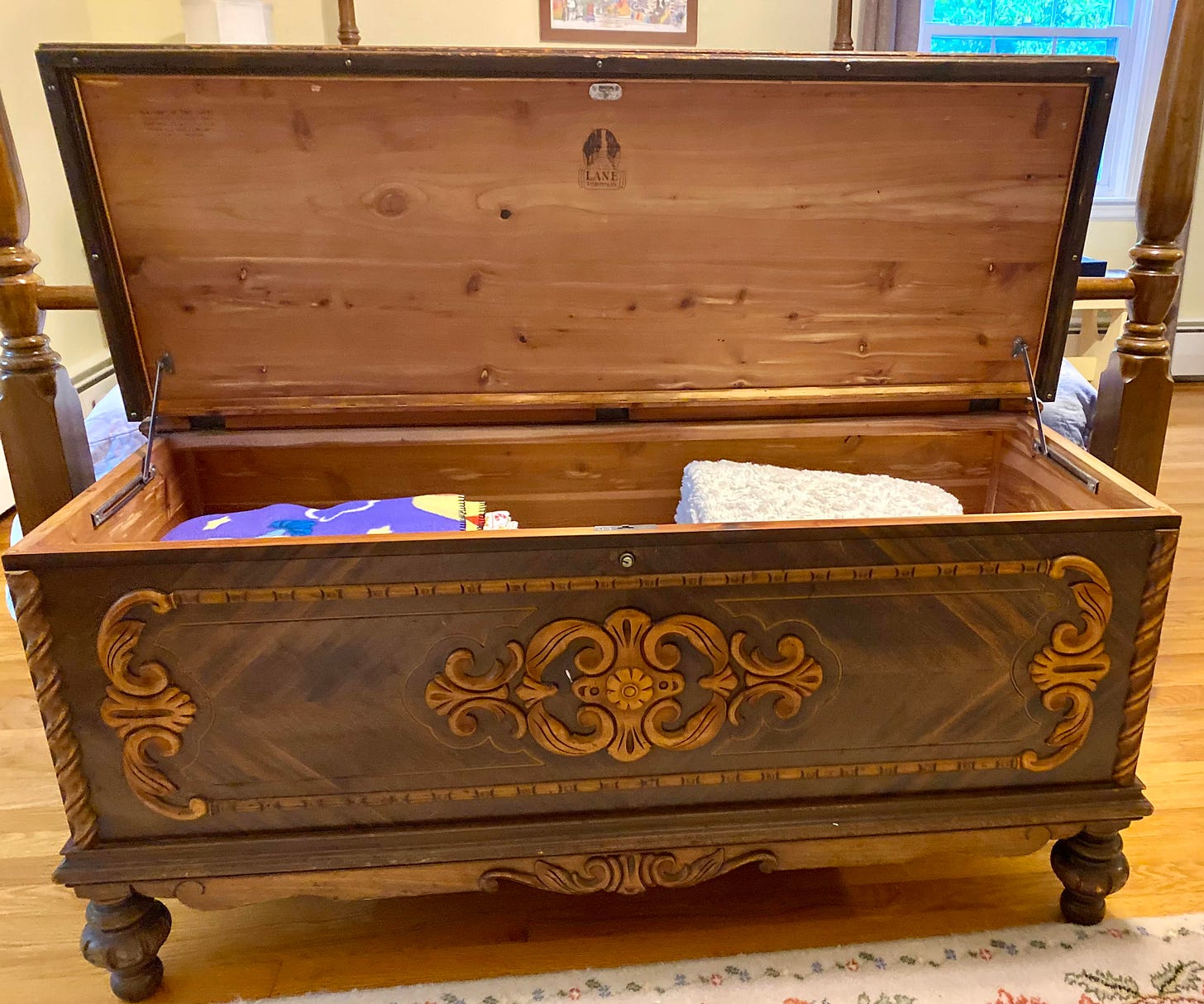What to Keep of Your Parents’ Belongings
And your grandparents'
I am reflecting on the downsizing process we undertook two years ago after meeting friends who are considering the same. I don’t envy them as it is/was not easy. I captured most of the emotions involved in my book of essays.
Along the way, I thought of what belongings people keep of their parents or grandparents. What will our children keep when we move along? Not easy. The easiest would be to toss it all. The difficulty is tied to emotion.
I am reminded of the days after my mother passed when we had to disassemble her house. Disassemble is an awful word in these circumstances. But is that not what we did? What other word(s) might I use? Estate liquidation? Ugh. How cold and calculating. House cleaning? No. That conjures a pail and mop.
Organizing the house? We weren’t organizing, we were closing. Closure. That’s it. It was closure because we were planning to sell the home. We were undertaking the emotional and sensitive task of cutting away the symbols of our memories. It was a challenge.
There were wistful moments as our families sorted through our parents’ belongings. Trying to hold on to bygone days made everything more difficult as we were immersed in memories and emotions. We found things that once barely registering were now precious treasures, more so than we’d imagined, like my father’s slide rule that he kept in his desk drawer.
It was hard to let go of even the merest; an ashtray from their New York honeymoon, Dad’s billfold, a set of keys, an old watch, vases, napkins, and wall hangings from forever ago. A drawer full of Mom’s scarves. Each book, each article of clothing, furniture, everything, represented a memory, a point in time as in “I was here when I saw this; when I picked that up.” These small, sentimental things had life. Everyday items had a story.
Our decisions needed to be efficient because it felt like we were doing something dreadful if we lingered. It took courage. It became easier as we sat at the table where we shared many Sunday dinners and joked about Mom’s ravioli and chicken croquettes. Adding a light-hearted tone made it doable I guess.
We sorted through pictures recalling days of their youth; before they were married before we were a family. Dad is dressed as if he were in a Gatsby movie, and Mom, a flapper. There was no way to tell they were working people and not Hollywood stars.
We weren’t decluttering. We were remembering. We wanted everyone to remember, so we asked relatives to come by to see what clothes of Mom’s they might want. Everyone seemed to have an attachment to something. Some looked wistfully at what they chose. We made it a social phenomenon, kinda like a day out, an excursion. Of course, we served coffee and pastry. Wouldn’t they?
The heap that we left on the table disappeared in the afternoon. The women were comforted by Mom’s clothes; some never worn, tags still hanging. The men loved Dad’s age-old tools; a worn wooden level, an old iron hedge clipper, wrenches, and whatever. It gave us a chance to laugh, sometimes to cry, with delight.
Some, many, we kept and bestowed affection on them. So, what’s the use of keeping things just to have them? Well, there is a reason. Because we are responsible for keeping memories alive. What did we keep?
Well, some of the classic furniture and some small things, like diaries, as reminders of our grandparents’ immigration, their early days in America, and, of course, the pictures, Dad’s billfold, Mom’s costume jewelry, a well-used coffee pot, its handle worn. We could smell the brew of those afternoons they spent together sipping in retirement. I found the old cloth Santa that Dad hung on the tree when it was born. I hung it on my tree.
Diane and I thought of our ‘stuff.’ What would our children keep? Would they care about the letters I saved from friends, teachers, mentors, and organizations? What about my neckties? Diane’s cookbooks? Her china and potteryware are treasures. Most of what we own has a practical use: chairs, tables, tools, pots and pans; things that provide a lifetime of comfort harboring memories of family, hard work, play, and hobbies. Our children probably don’t want that stuff. They have theirs.
We’re sifting through a boatload of things, trying to figure out how to dispense with what we can part with now.
We walk by my parents’ timeworn furniture, sometimes sliding a finger along the edge. We look at the old pictures. They provide an indefinable comfort.
It’s life’s arc from grandparents to parents to ours to our children, and in the arc is stuff. And in the stuff is a life, many lives. And in the lives are memories. And what to keep is challenging, and emotional. But the arc embraces us. How nice.






Oh my God, what a sweet, sad story. I wanted everything my father put his hands on when he passed away.
Even as a young kid, I struggled to get rid of small things, because I knew I was leaving a memory behind in each thing I passed on. I guess a part of life is paring our own stories down into the parts that others might find useful. But it is painful.